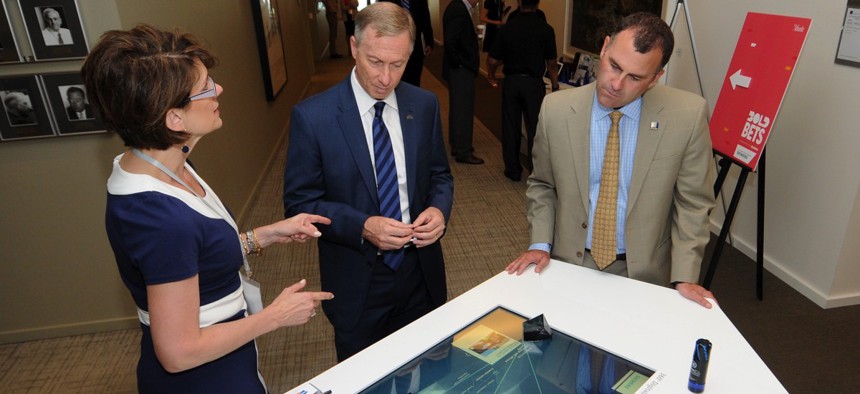If You Build Broadband Infrastructure, Data Centers Will Come

From right, Mayor Rusty Bailey of Riverside, Calif., Mayor John Giles of Mesa, Ariz., and Cathe Reams of Siemens. Carlos Delgado / AP Photo
That’s what Mesa, Arizona, has found as it’s installed an elaborate network of conduits and fiber during routine street improvement projects.
Next Century Cities will host a regional broadband summit in Mesa, Arizona, for the first time April 17-18, a milestone for a municipality that built its own network to lease to internet service providers.
Cable companies CenturyLink and Cox are the first two to secure license agreements with the city, but they’re non-exclusive.
Now comes the task of expanding broadband accessibility, the best practices for which Mayor John Giles has explored through the U.S. Conference of Mayors and National League of Cities and soon Digital Southwest.
“We’re very interested in it because I think it reflects the reality to us that we live in a world of the Internet of Things,” Giles told Route Fifty in a phone interview on Monday. “It’s important to facilitate broadband access so residents have convenient services . . . We’re anxious to be leaders in the field.”
That mentality has made Mesa a market for data centers like Apple’s $2 billion, 1.2-million-square-foot Global Command Center—built last year and already expanding the devices it produces to include enterprise data server cabinets.
“One reason is because East Valley employment corridors like the Elliot Road Technology Corridor in Mesa were designed with the needed infrastructure to facilitate at least one data center,” Az Big Media reported in January.
The city spends a lot of money on infrastructure, especially in industrial areas, and most of it goes toward improvements you can’t see: conduits and dark, or unused, fiber-optic cables underground.
Mesa has developed an expansive broadband network piggy-backing such work on street improvement projects to save money, and its business community is now reaping the benefits, Giles said.
“Smart cities, as often as possible, try to do two or three things at a time—you try to get a ‘twofer,’” he said. “You improve the streets but also increase their marketability with fiber.”
Mesa’s Fiesta District is a prime example. Once the city’s commercial center, the district fell into disrepair about 30 years ago.
City Hall approved street improvement bonds improving the area’s aesthetics while attracting retail and commercial development because of what was below street level.
Free Wi-Fi is available downtown, in all city buildings and in public libraries.
Giles is among the city leaders advocating digital inclusion of economically challenged community members. CenturyLink and Cox have been asked to provide better, faster service and participate in city programs ensuring low-income households can get internet for less than $10 a month, if they have students who need to do homework online.
Homeless and tourist populations are trickier to serve—many of the former coming in via the greater-Phoenix light rail—which is why Mesa wants a robust broadband network. That needs to be balanced with local technology regulations that don’t “threaten people’s privacy and safety,” Giles said.
Like most local government officials, the mayor is hopeful all or most of President Trump’s vague-but-lofty infrastructure plans will be realized and that broadband is part of them. Trump’s promise of $1 trillion in new infrastructure spending is “music to the ears of cities and towns,” Giles said, but congressional agreement might not be there.
“The reality in this Internet of Things world we live in now still needs bridges, roads and schools,” he said. “But you can’t ignore broadband as an essential part of our lives anymore, so that’s got to be figured into infrastructure development.”






